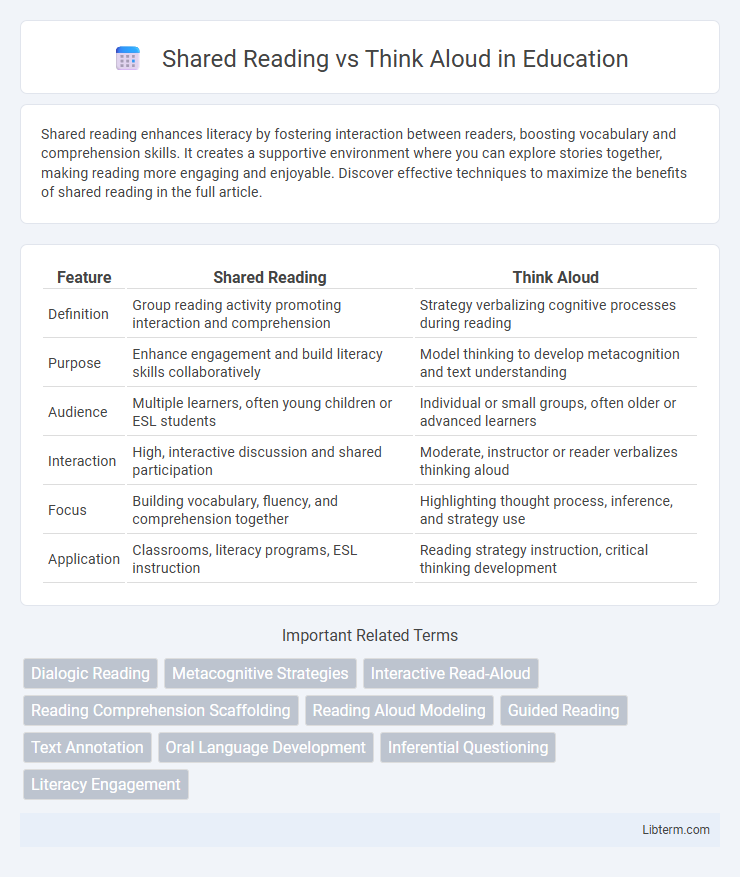Shared reading enhances literacy by fostering interaction between readers, boosting vocabulary and comprehension skills. It creates a supportive environment where you can explore stories together, making reading more engaging and enjoyable. Discover effective techniques to maximize the benefits of shared reading in the full article.
Table of Comparison
| Feature | Shared Reading | Think Aloud |
|---|---|---|
| Definition | Group reading activity promoting interaction and comprehension | Strategy verbalizing cognitive processes during reading |
| Purpose | Enhance engagement and build literacy skills collaboratively | Model thinking to develop metacognition and text understanding |
| Audience | Multiple learners, often young children or ESL students | Individual or small groups, often older or advanced learners |
| Interaction | High, interactive discussion and shared participation | Moderate, instructor or reader verbalizes thinking aloud |
| Focus | Building vocabulary, fluency, and comprehension together | Highlighting thought process, inference, and strategy use |
| Application | Classrooms, literacy programs, ESL instruction | Reading strategy instruction, critical thinking development |
Introduction to Shared Reading and Think Aloud
Shared Reading involves an interactive reading experience where a teacher models fluent reading and engages students in discussion to enhance comprehension and vocabulary development. Think Aloud is a strategy where the reader verbalizes their thought process while reading to make metacognitive strategies explicit, improving critical thinking and text analysis skills. Both methods aim to support literacy but differ in their approach: Shared Reading focuses on collective participation, whereas Think Aloud emphasizes individual cognitive monitoring.
Defining Shared Reading
Shared Reading involves an interactive reading experience where the teacher and students engage with a text together, promoting literacy through collaborative dialogue and repeated exposure to vocabulary and text structures. This method emphasizes guided participation, allowing learners to develop comprehension skills and phonemic awareness in a supportive environment. Shared Reading contrasts with Think Aloud by focusing on collective reading engagement rather than individualized cognitive processing during reading.
Understanding the Think Aloud Strategy
The Think Aloud strategy involves vocalizing thoughts in real-time while reading, enabling readers to monitor comprehension and engage deeply with the text. This method promotes active processing by making internal cognitive processes explicit, helping learners identify and clarify misunderstandings. Unlike Shared Reading, which emphasizes collaborative reading and social interaction, Think Aloud primarily targets individual metacognitive awareness and self-regulation skills.
Key Differences Between Shared Reading and Think Aloud
Shared Reading involves interactive group experiences focusing on reading fluency, comprehension, and engagement with a text, typically guided by a teacher or leader. Think Aloud emphasizes individual cognitive processing, where the reader verbalizes thoughts to model comprehension strategies and critical thinking during reading. The key difference lies in Shared Reading's collaborative approach to building literacy skills versus Think Aloud's introspective method to demonstrate metacognitive reading processes.
Benefits of Shared Reading in Literacy Development
Shared reading enhances literacy development by promoting vocabulary acquisition and comprehension skills through interactive engagement with texts. It fosters a supportive learning environment where children can develop print awareness and narrative understanding by observing and participating in reading processes. This collaborative approach also strengthens language development and motivation to read, laying a foundational skill set for independent reading success.
Advantages of Using Think Aloud in the Classroom
Think Aloud enhances metacognitive skills by allowing students to verbalize their cognitive processes during reading or problem-solving, promoting deeper comprehension and critical thinking. It provides real-time insight into students' thought patterns, enabling teachers to tailor instruction to individual learning needs and address misunderstandings promptly. The strategy fosters active engagement and encourages learners to reflect on their reasoning, boosting retention and application of knowledge across subjects.
When to Use Shared Reading vs Think Aloud
Shared Reading is ideal for early literacy development and fostering group engagement, allowing readers to experience fluency and comprehension collectively in real-time, especially with young or emergent readers. Think Aloud is best utilized for modeling cognitive strategies during complex text analysis, helping advanced learners or individuals struggling with comprehension to internalize metacognitive processes. Employ Shared Reading when building foundational skills and social interaction; use Think Aloud to enhance critical thinking and independent reading skills.
Practical Examples of Shared Reading Activities
Shared reading involves interactive activities such as reading picture books aloud while encouraging children to predict story outcomes, discuss characters, and connect the content to their own experiences. Practical examples include using big books or enlarged text for group reading sessions, incorporating repeated refrains for participation, and asking open-ended questions to enhance comprehension and vocabulary development. These activities foster engagement, language skills, and critical thinking in early literacy settings.
Effective Think Aloud Techniques for Educators
Effective think aloud techniques for educators include modeling metacognitive strategies such as predicting, questioning, and clarifying while reading aloud to students. Unlike shared reading, which emphasizes collaborative participation, think aloud focuses on explicitly demonstrating the internal thought processes that skilled readers use to understand text. Incorporating visual cues, probing questions, and verbalizing confusion helps students develop critical reading comprehension skills and fosters independent analytical thinking.
Integrating Shared Reading and Think Aloud for Optimal Learning
Integrating Shared Reading and Think Aloud strategies enhances literacy development by combining collaborative text engagement with metacognitive modeling, promoting deeper comprehension and critical thinking skills. Shared Reading allows learners to experience fluid reading and vocabulary expansion, while Think Aloud encourages active reflection on reading processes and strategies. Employing both approaches synchronously fosters a richer learning environment, enabling educators to scaffold understanding and support diverse learner needs effectively.
Shared Reading Infographic

 libterm.com
libterm.com